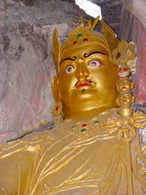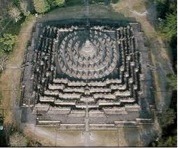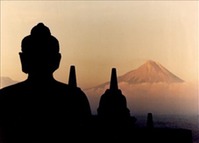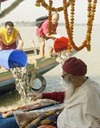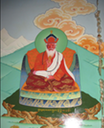His Holiness Chatral Rinpoche (June 18, 1913 – December 30, 2015) was one of the most highly realized Dzogchen yogis and compassionate Boddhisatva in our time. Rinpoche was born in the Nyag Adzi Valley of Eastern Tibet in 1913, in the year of the Female Water Ox, on the morning of the auspicious 10th day of the fifth month, celebrated each year as the day Guru Rinpoche manifested the form of Dorje Drollo and concealed countless terma treasures, teachings and samaya substance across the length and breadth of Tibet and beyond.
His father was Pema Dondrub whose family line was Mukpo Dong and his mother, Sonam Tso, was a member of the Wakyung family. He was married to Kamala and had two daughters, Tara Devi and Saraswati. He left home at fifteen, travelling extensively on foot to receive teachings and to practice. He studied with some of the most respected lamas of the last century: Khenchen Ngawang Palzang, HH Dudjom Rinpoche, Jamyang Khyentse Chokyi Lodro, and the dakini Sera Khandro.
He was one of the primary lineage holders of the Longchen Nyingthig, and in particular the lineage that descends through Jigme Lingpa's heart son Jigme Gyalwe Nyugu and then on to Patrul Rinpoche. HH Chatral Rinpoche was closely associated with the Dudjom Tersar lineage. HH Dorje Dragdul, one of Terton Dudjom Lingpa's sons, gave him these transmissions. He was empowered as the regent of His Holiness Dudjom Rinpoche and passed on this lineage back to this master's tulku, who lives primarily in central Tibet. He also held the Sera Khandro Terma.
It was the abbot of Kathok monastery, Khenchen Ngawaang Palzang (Khenpo Ngakchung) especially, though, who was Rinpoche's root guru and who bestowed the Longchen Nyingthig "heart drop" teachings on the essential point concerning the mind's nature. His greatness was first revealed in the 1930′s when his root teacher Khenpo Ngawang Palzang, author of 'A Guide to the Words of My Perfect Teacher', told a large assembly that “his realization is no different from mine.”
"Beginning with the preliminary practices and continuing through the progressive stages of the path up to and including Trekcho and Togal belonging to the Innermost Luminosity, he was bestowed an oceanlike amount of Dharma teachings from the sutras, tantras and oral instructions, like a vase filled to the brim. Bringing them into the sphere of practice, the realization of Dzogchen’s great equanimity dawned in his mind. He realized the four levels of vision and reached a high stage among the learned and accomplished beings in this world. In this way, he is significantly replete with the qualities of experience and realization." Khenpo Tendzin Özer translated by Erik Pema Kunsang.
He was crowned with the name Chatral Sangye Dorje by The Mahapandita Khenpo Ngawang Palzang Rinpoche and entrusted with the teachings and his spiritual aspirations.
Fulfilling prophesies from the past, he became the personal guru of Tibet’s regent king, the honorable Jampal Yeshe Tenpey Gyaltsen of Reting. By this time His Holiness Chatral Rinpoche was attracting a great deal of public attention with people of all backgrounds making offerings to him and requesting teachings. He decided to make a dignified exit from the distraction this represented and set off to practice alone as a hermit in secluded caves for some decades. This is how he acquired the name "Chatral" meaning "hermit".
During the nineteen fifties, he moved to Bhutan and later to India. He led the restoration of a temple near Darjeeling and was the first Tibetan Lama in exile to establish a meditation retreat school. He continued to build other drupdras, temples and stupas in Nepal and India including Pharping in the Yolmo are of Nepal where he is now primarily based.
He was a ngakpa who had consistently shunned institutional and political involvement, choosing instead whenever possible to live the life of a wandering yogi ceaselessly working to overturn samsara for all sentient beings. For many years in Tibet, Chatral Rinpoche meditated alone in caves and was renowned as a realized yogi. From the outset Rinpoche chose whenever possible always to walk on foot, declining the use a horse. He preferred always to stay in caves, hermitages or in a small tent, never wishing to accept the invitation of wealthy patrons to stay in the their house. Even today he stays in his own small place in Parphing Nepal near a sacred site of Guru Padmasambhava who founded Buddhism in Tibet.
Despite his great age he was never to stay long in one place. As a ngakpa he maintained strict discipline in the context of the Dzogchen view. Untypically, for a ngakpa, however, he was especially well known for promoting vegetarianism. His yearly practice of ransoming the lives of thousands of animals in India was legendary. In addition to his emphasis on the union of view and conduct, Rinpoche also stressed the practice of retreat.
Reference:
Compassionate Action, Chatral Rinpoche, Zach Larson
Photos of H.H. Chatral Sangye Dorje Rinpoche
